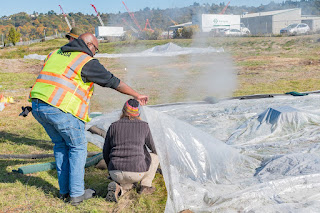Karla Salp
Communications
 |
| Vineyard snail |
The invasive snail is Cernuella virgata but most people just call it the vineyard snail. The snails pose a threat to agriculture by directly attacking crops – such as wheat – and also clogging up machinery when farmers try to harvest their crops.
And while most people think of steaming snails as more of a culinary endeavor, WSDA’s Pest Program is gearing up to use steam treatments to eradicate invasive snails at the Port of Tacoma late this summer.
The vineyard snail was first detected at the Port of Tacoma in2005 and WSDA has been working to eradicate the population since 2007. The project has been a collaboration between WSDA, the Port of Tacoma, and Washington State University (WSU). The initial infested area was approximately 300 acres but now has been reduced to less than one acre on a single property. The last acre has proven to be a real challenge, as it is classified as a wetland and traditional treatment methods are not available. The hope now is to complete the eradication using experimental steam treatments – a potential alternative to pesticide-containing snail baits.
A snail-steaming solution
 |
| Snail steam trial at Port of Tacoma |
Part of the challenge, though, is identifying which snails are native and which are invasive. Vineyard snail looks very similar to some native snails, and it takes a trained eye to spot the difference. Even then, it can be tricky. To help positively identify the invasive snails, WSDA has turned to DNA to provide greater certainty.
DNA – stopping invasive species in their tracks
WSDA’s molecular diagnostics laboratory in Olympia has been a game-changer in the Pest Program’s ability to respond to pest issues. Rather than having to wait days or weeks to get DNA analysis back from a federal lab, WSDA’s molecular diagnostics lab is running its own tests and getting results back within hours. These quick results enable the program to make mid-season adjustments when responding to invasive pest threats, rather than having to wait until the following year.
When responding to invasive pests – a quick response can mean the difference between eradicating an invasive threat quickly -- or having to learn how to manage it forever.
The lab ran into a problem when starting to look into DNA analysis of snails: very little snail DNA exists in national DNA databases. Without enough samples to use for comparisons, the lab cannot provide meaningful DNA results.
Sequencing snails
 |
| Snail segments from Germany |
USDA APHIS is obtaining and expertly identifying the snails, WSDA is processing and sequencing the DNA, and the Smithsonian is analyzing the DNA sequences.
This month the first (dead) snails arrived from Germany, and the WSDA molecular lab began the process of extracting and sequencing the DNA. When complete, the results will do more than just help WSDA quickly identify vineyard snail. It will provide agricultural authorities around the country needed DNA information to positively identify various Cernuella species and protect our nation’s natural resources from invasive pests.
 |
| Electropherogram from German snail DNA |
